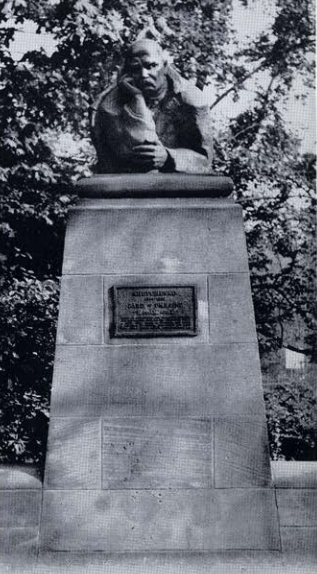Part Two. Links in the Chain: History of the Cultural Gardens
Ukrainian Cultural Garden


The Ukrainian Cultural Garden is located on the west side of the lower boulevard, opposite the Greek Garden level. Brick and stone courts are connected by paved walks to produce a richly formal effect in a background setting of varying shades of green. The entrance is to the left court through a stone and iron gateway bearing bronze plaques and portrait reliefs by Frank L. Jirouch, representing Bohdan Khmelnitsky (1593-1657), leader of a revolt against the Poles in 1614, and Mikhail Hrushevsky (1866-1934), historian, teacher, and author. Main interest centers around three bronze busts of famous Ukrainians–Ivan Franko (1856-1916), poet, patriot, and folklorist; Volodimir the Great (956-1015), first Christian ruler of the Ukraine; and Taras G. Shevchenko (1814-1861), poet, teacher, reformer, liberator of Serfs in Russia whose >popularpoems have won him the name of the Father of Ukrainian Literature. These three busts are the work of Alexander Archipenko, world-famous master of modern art and one of the founders of cubism, who was born in Kiev, the ancient capital of Ukraine. These sculptures thus greatly enrich the art treasures of Cleveland.
The Ukrainian Garden was completed in 1939. By a City Proclamation, Mayor Harold H. Burton designated June 2, 1940, for the formal dedication of the Ukrainian Cultural Garden. “Whereas the Ukrainian Cultural Gardens form a strong and important link in the chain of the Cultural Gardens,” the Proclamation read in part, “and whereas these Ukrainian Gardens are symbols of the contribution of the Ukraine to the cultural and spiritual development of the world . . . as mayor of Cleveland, I designate Sunday, June 2, 1940 as the day for the formal dedication of the Ukrainian Cultural Garden in Rockefeller Park, and I invite all who can do so to participate in the dedicatory exercises.”
On June 1, 1940, an impressive and well-attended pre-dedication concert was given in the Music Hall of Public Auditorium. The famous National Chorus “Dumka” of Detroit, the Ukrainian Dancing Guild and guest soloists, Maria Sokil, Olga Lepkova, and Antin Rudnitsky, were featured. Mrs. Harold H Burton extended greetings on behalf of her husband, the mayor.

The dedication ceremonies on June 2, 1940, were attended by over 8,000 persons, including many out of town guests. Professor Clarence A. Manning, head of the department of East European languages at Columbia University of New York City, delivered the principal address. Mayor Burton accepted the new garden on behalf of the city. Other speakers included Dr. Luke Myshuha, editor of the Ukrainian daily “Svoboda,” of New York, Archbishop Ivan Theodorovich of Philadelphia, and Charles Wolfram, then president of the Cultural Gardens Federation. Omer E. Miles, attorney, and president of the United Ukrainian Organizations, was chairman and master of ceremonies.
Governor John W. Bricker sent a message congratulating the United Ukrainian Organizations on their Cultural Garden undertaking, and expressing his conviction that the Ukrainian Garden would do much to acquaint citizens generally with Ukrainian history and with the achievements of Ukrainian scholars, writers, and poets.
The Ukrainian Cultural Garden was developed, with the aid of Federal and City grants, principally by the United Ukrainian Organizations of Cleveland a. central council, composed of clubs, societies, and associations for the purpose of directing and encouraging cultural, educational, and welfare work among the 25,000 Ukrainians of Cleveland. This organization is affiliated with the Ukrainian Congress Committee of America, which strives to assist morally, politically, and financially, the liberation of Ukraine, and to attain its sovereignty. Its generous and tireless members and its enterprising executive board, composed of Omer E. Miles, John Spodar, Harry Stepanek, Dmytro Szmagala, William Wolansky, Theodore Haycey and Walter Woycitsky, have been largely instrumental in enriching Cleveland with this magnificent garden.

The home of the Ukrainian people is the vast and fertile prairie stretching from the Carpathian Mountains eastward to the Sea of Azov. Several rivers, of which the Dnieper is the largest, cross the country in the same general direction from north to south, running into the Black Sea or into the Sea of Azov. In the north the Ukrainians have expanded from the steppes to the forest zone, especially on the right bank or the Dnieper River, so there is no natural northern boundary to their country.
Nature has showered her gifts lavishly on Ukraine. The famous “black earth” (chornozem) is among the richest in the world, and since the end of the eighteenth century Ukraine has been known as the “granary of Europe”.
Here the aboriginal Slavic tribes from which the Ukrainians descend lived from time immemorial But while God favored the land with His gifts, man was not left to live there in peace and abundance. From prehistoric times, Ukraine has been a battlefield between east and west, north and south.
The Ukrainians have sometimes been termed “the Irish of the Slavonic World”, and the epithet is not infelicitous. In both cases there is a tradition of ancient, almost legendary glory, followed by long centuries of stifled independence, in which the stream of national life disappeared underground almost completely-–only to emerge in turbid and eager flood in modern times.
The Ukrainian language is an East Slavonic tongue which is closely akin to Russian but which differs from it very sharply in many important grammatical and phonetic ways. The language is spoken by a people of some forty millions in number who are almost wholly included in what is known as the Ukrainian Socialist Soviet Republic. Before the Second World War, the country was divided between the Soviet Union, Poland, Romania and Czechoslovakia. Before the First World War, it was divided between Russia and Austria-Hungary.
The individuality of the Ukrainians as a people stands out clearly, despite conquerors’ efforts to assume their past, deny their present, and alter their future.

